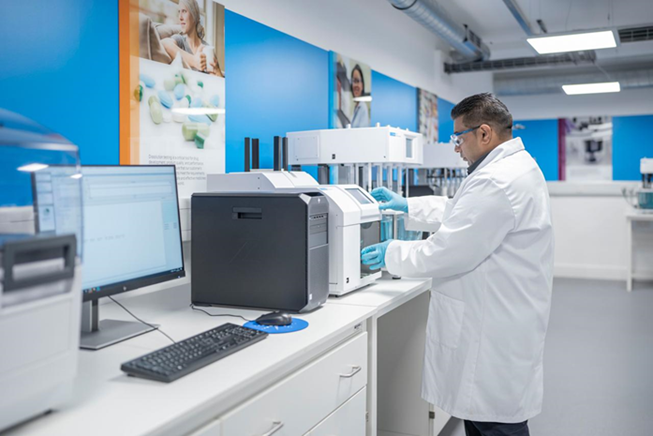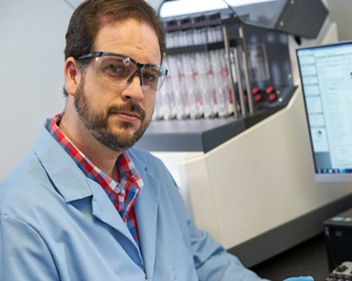In the previous post, I talked about the merits of automated sampling in the dissolution workflow. Here, I will provide some information about how to validate your automated dissolution system, using the 850-DS Sampling station from Agilent as an example.

Part 2: How To Validate Your Automated Dissolution System?
When performing a transfer of a manual dissolution method to an automated sampling system, it is necessary to validate this system for each product and/or method for equivalence.
 (Credit :The information summarized in the article was originally published on LinkedIn by our Dissolution Product Specialist Ken Boda)
(Credit :The information summarized in the article was originally published on LinkedIn by our Dissolution Product Specialist Ken Boda)
Ken Boda – Dissolution Product Specialist
To ensure that you are getting accurate and equivalent results with the autosampler you should follow these 4 steps:
- Setting the pump parameters correctly
- Checking the tubing adsorption and filter validation
- Checking sampling bias (automated vs manual sampling)
- Ensure effective cleaning
Step-1: Setting the Pump parameters correctly
It is critical to understand the pump parameters of different vendors for accurate automated sampling. Here is some guidance for performing autosampler validation for Agilent’s 850-DS Sampling station.
A very distinct feature of the 850-DS is its closed-loop design which provides the ability to recirculate dissolution media back to the dissolution vessels and thereby minimizing volume lost to waste. So, it is important to know the exact mL of volume removed from vessel at each time point.
The 850-DS has important pump setting parameters like:
- Prime loss volume: The volume of the complete fluidic path starting from the tip of sampling cannula to end of sampling needle or flow cell (online UV-dissolution system). Fill the complete tubing length using ‘Diagnostic’ feature. Once filled completely, collect the whole volume into a clean test tube and measure it to calculate the Prime Loss Volume. Prime Loss Volume is determined to ensure that the sample collected is that which is withdrawn at the specified time point.
- Prime volume: The volume of media from vessel used to prime the sampling lines prior to sampling. It helps to overcome adsorption on filters and dilution in sampling lines. It is a product/method specific parameter and should be optimized accordingly.
- Purge volume: The volume of air purged through sampling lines after completion of sampling. It ensures that the lines are emptied of leftover sample before pulling the next one. It is also a product/method specific parameter.
- Waste drop volume: The volume of sample pushed through the needles prior to dispensing the sample into collection vial. It ensures that you are not mixing your current sample with the previous one. It is recommended to set this to 0.5 mL for 850-DS.
If you optimize these parameters correctly for your method, you should expect accurate samples from the 850-DS that match your manual sampling data. These parameters must be determined for all your products individually to adjust for product, dissolution media, filters, etc. Please refer the Method setup quick-start guide for setting the key 850-DS pump parameters correctly.
If you are intending to use Whatman 850-DS nylon 8-channel filter plates with 850-DS, you must determine the above-described parameters using the filter plates.
Step-2: Checking the Tubing Adsorption and Filter Validation
Next, let’s focus on checking the sampling tubing adsorption for the product being used and performing the necessary filter validation.
The adsorption test is performed to ensure that the drug or active pharmaceutical ingredient (API) is not being adsorbed into any part of tubing or autosampler. We have seen many cases where the API binds to tubing and causes lower results. Adsorption of the drug is most obvious in early sampling points or in low dose formulations.
To check the adsorption, you can follow these steps:
- Prepare a standard solution for your drug product that is a little lower concentration than you expect at the first sampling point.
- Put this standard solution into a dissolution vessel.
- Set the automated sampling parameters as your original dissolution method and run a program with a single withdrawal point, sampling from that vessel.
- Analyze and compare the standard solution withdrawn from autosampler with the standard solution from your original flask. There should be less than 1% difference in the result.
If you already have dissolution method with manual sampling and using same filter for automated sampling, there is no need to perform Filter Validation. If you wish to use an alternate filter, follow the filter validation protocol developed by Agilent experts.
Step-3: Checking Sampling Bias (Auto sampler vs Manual sampling)
This is one of the most discussed topics among the Dissolution community. For dissolution testing, manual sampling is always considered to be the correct result. Though automated sampling provides better precision in the results, you demonstrate equivalence for all your products/methods when moving to an automated solution. Use of an autosampler must not create any bias due to hydrodynamic differences.
The sampling probes are a potential reason for causing different results due to the hydrodynamic differences in the vessels. Imagine the pattern of current when a log stuck in a river vs smoothly flowing river. It is advantageous to limit the amount of time that the probes are in the dissolution media. For example, resident probes – probes that remain immersed throughout the dissolution test – have a larger hydrodynamic impact than those that are lowered only when withdrawing a sample. Another key factor is the place from where the sample is pulled. The more consistent sampling location is the better – in fact, when considering automated dissolution systems, the more the system can mimic manual processes, the better the probability of having success when performing automated system equivalence for your methods or products.
In the Dissolution troubleshooting article published in Dissolution Technologies, there are several case studies for investigation of dissolution failures during QC testing and product development stages. Case studies 6 and 7 here show the impact of automated sampling in dissolution failure.
To check the bias in your results, f2 analysis of the same lot of products can be performed. In this case, you can compare the results of n=12 manually withdrawn vs n=12 autosampler withdrawn samples. Please note that you have to run both the dissolution tests separately for manual and automated sampling. You must not manually withdraw samples from the same run as automated sampling.
Step-4: Ensure effective cleaning
Lastly, it is important to make sure that the autosamplers are cleaned properly after each test. It will not only prevent the carryover between dissolution runs but also keep the system healthy. Without proper cleaning, buildup of residues in autosamplers will lead to damage of the needles, tubing, valves, and syringes that comprise the system.
Agilent recommends following points for proper cleaning of both the autosamplers and the dissolution units:
- Choose cleaning solutions and protocol depending upon the nature of your product (API and excipients) and dissolution media.
- Clean the system as soon as the dissolution run is completed. It is the same case as dishes in the sink (residues become difficult to remove over time). The Agilent 850-DS has an auto clean function and reservoir for cleaning solution. So, you can select the auto clean function in your dissolution method and ensure that the system gets cleaned immediately after the run is finished.
To perform cleaning validation of your method, run a dissolution method first. Clean your dissolution unit and autosampler with the planned protocol. Next, fill the same vessels with fresh dissolution media and perform a method with one sampling time point using the autosampler. After analyzing the sample, you should be getting less than 1% carryover from the previous sample. The lower the carry over, the better the cleaning method.
You may have to perform several runs to optimize the best cleaning solution and number of cycles for adequate cleaning of the dissolution system for each of your products.
I hope you have found this blog useful, and it will help you to validate the autosampler for your product(s). For more information and support, check out the following resources from Agilent’s Dissolution team of experts or reach out to us directly at dissolution.hotline@agilent.com.
